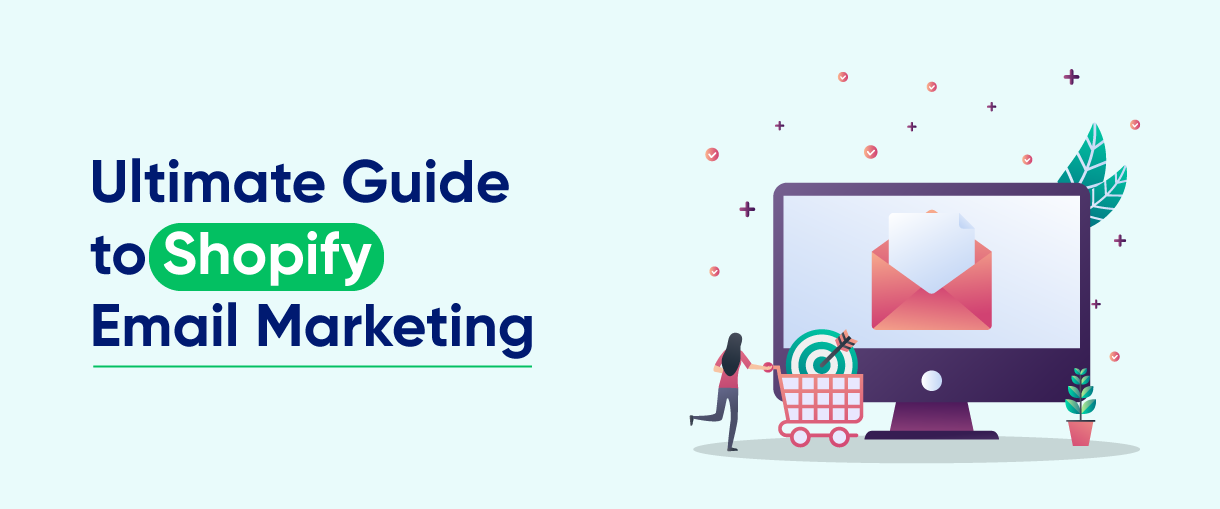Do you have an online store on Shopify and want to increase sales and customer loyalty? Email marketing can be a perfect tool for your eCommerce business, but setting up a successful strategy can be difficult, especially if you’re new to the game. Don’t worry; we’ve got you covered!
In this ultimate guide to Shopify email marketing, you’ll learn everything you need to know to create effective email campaigns that resonate with your target audience, drive conversions, and take your business to the next level.
So, let’s begin by discussing some important terms!
What Is Email Marketing?
Email marketing is an effective marketing channel enabling online businesses to communicate and share information with their potential customers. It offers a platform to alert subscribers about upcoming sales, share discounts, announce new product arrivals, and provide updates on order fulfillment.
Email marketing can be a perfect strategy for new businesses to establish a customer base and increase sales. By sending regular messages, businesses can encourage buying with sales and nurture leads who may not be ready to buy. This allows them to connect with their consumers and build brand loyalty over time.
Different Types Of Email Marketing
Below, we have explained the different types of email marketing that you must know about:
1. Welcome emails
Welcome emails are the initial messages that subscribers receive. They serve as a way to introduce the brand to the customer. These emails are automatically sent when someone subscribes to a newsletter or places an order.
Welcome emails are highly effective marketing emails. This makes them an excellent opportunity to encourage customers to make their first purchase by offering an incentive.
2. Newsletters
The next type of email is a newsletter. The newsletter’s main aim is to give consumers updates about your brand. You can send regular email newsletters to your customers and tell them about offers, discounts, sales, new products, and much more.
Here are different types of content that a brand might share:
- News and updates
- Product updates, such as new arrivals
- Blog content, including articles and case studies
- Regular marketing offers, such as sales
- Contests, giveaways, and promotions
3. Brand story emails
Did you know that 77% of customers tend to purchase from brands that share their values? That’s why brands build marketing strategies based on their unique missions, visions, and values. Emails can be a powerful tool to share this content with customers directly.
Consider adding your brand’s story to your Shopify email marketing campaigns. It’s a simple yet effective way to describe how your brand started and the values you stand for. This could be a great idea, especially if you incorporate some storytelling.
4. Re-engagement emails
It’s common for some of your email subscribers to stop engaging with your messages. However, it’s not necessarily your fault. The average email user receives approximately 50-60 emails every day, so it’s easy for messages to get lost in the shuffle. To win back these customers, many businesses will send re-engagement emails.
Re-engagement campaigns typically involve sending emails to subscribers who have stopped opening your messages. These emails will ask if they’re still interested in receiving your content. These campaigns are usually sent 30-60 days after the subscriber stops engaging with your emails.
5. Transactional emails
Whenever a customer places an order or subscribes to a newsletter, an email marketing tool automatically sends a confirmation email. Such emails are known as transactional emails, which aim to inform or confirm customers that their action has been completed successfully.
The common types of transactional emails in eCommerce include:
- Order confirmation emails
- Order shipment confirmation emails
- Payment refund emails
- Password reset emails
- Delivery confirmation emails
- Invoice emails
- Legal terms update emails
- And newsletter subscription emails
4 Important Steps To Build Your Shopify Email Marketing Strategy
Once you understand different types of emails, it’s time to start building your Shopify email marketing strategy. This will help you effectively reach your customers and increase your sales.
Keep scrolling!
1. Think through your consumer journey
Remembering a few best practices when writing customer and prospect-facing emails is important. Firstly, always think through the customer journey and ensure your email serves a clear purpose. Whether a promotional or a transactional email, the content should be tailored to guide the reader towards completing the intended goal.
2. Write a catchy subject line
Another crucial aspect is writing a catchy subject line. Your email will likely remain unopened if your subject line doesn’t grab the reader’s attention. Keep your subject line interesting and concise to make a good first impression, ideally around 50-60 characters.
3. Send from an operational email address
It is crucial to send emails from an operational email address. The “from” and “to” email fields should match whenever possible. If this is not feasible, you should use an email address capable of sending and receiving emails. This way, your potential customers and clients can ask questions by simply replying to the email.
4. Use a clear call to action
Last but not the least! Adding a clear call-to-action (CTA) is key. A CTA defines the action you want your reader to take. Whether clicking through to your website or signing up for a free trial, ensure the CTA is prominently displayed and easy to understand. Limiting your CTA to one action is best practice, as calling for multiple actions at once may harm your intended goal.
Conclusion
Shopify email marketing is one of the best tools to help your online store grow and thrive. By crafting personalized and targeted email campaigns, you can build stronger customer relationships, drive more sales, and ultimately achieve your business goals. So don’t hesitate to invest time and resources into your email marketing strategy – it’s a smart move that can pay off in a big way.

